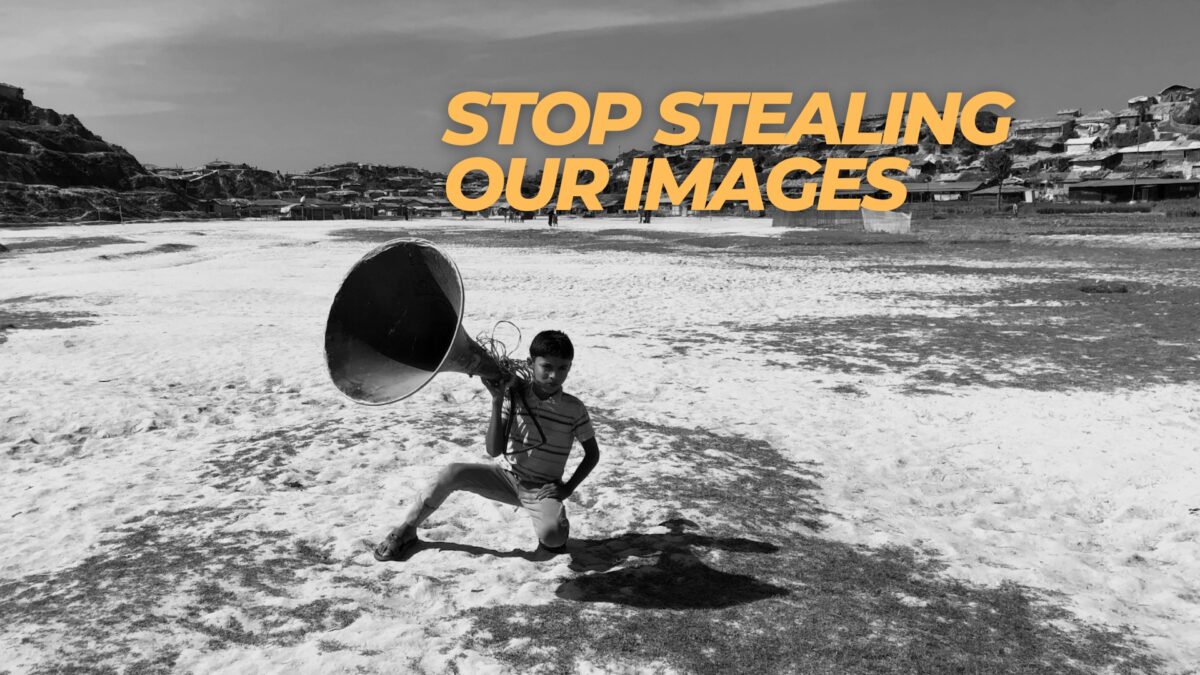Since the military coup in February 2021, the situation for the Rohingya community of Myanmar has become increasingly dire, with severe breaches of international law and human rights being committed, such as arbitrary detention, torture, sexual violence, and murder. The Rohingya have been victims of genocide for decades, and the Myanmar military is currently targeting over 600,000 of them who remain in the country. As a result, many Rohingya have been compelled to flee to neighbouring countries, where they are still experiencing human rights violations, including human trafficking and deportation. Over 1.1 million Rohingya refugees currently live in refugee camps in southeastern Bangladesh, and are confronting a multitude of challenges.
These Rohingya refugees don't have a voice in general; for decades, some of their voices were highlighted by visiting journalists and were sometimes filtered before they reached the outside world of the camps. Nevertheless, a number of young Rohingya refugees are using their phone cameras or professional cameras to document their lives in the refugee camps and tell their own stories using social media.
Despite international efforts to mitigate the crisis, and repatriate them, the Rohingya refugees continue to suffer, exploited by different quarters. In recent years there have been a number of incidents where some of these Rohingya photographers found that their photos were used by international non-profits, and media houses without consent or paying for them. This runs counter to the fundamental values of journalistic integrity and ethical behaviour that underpin the notion of accountable journalism and professionalism. Moreover, the struggles of these photographers to claim their rights remain often unheard.
Some of their lone voices echo on social media platforms, such as this tweet by Rohingya photographer Md Jamal in December 2022:
STOP USING OUR PHOTOS WITHOUT AUTHORISATION.
Today @MohammedZonaid8 & I resolved an issue with an online news site. They used our photos without our permission. This is illegal. #Rohingya photographers’ work may ONLY be used WITH consent.
Thanks @RohingyaPhoto for advice pic.twitter.com/AkPoBj6AEV
— Md Jamal Photography (@mdjamal315) December 1, 2022
UK-based British-Bangladeshi journalist and documentary filmmaker Shafiur Rahman launched the first Rohingya Photography Competition (RPC) in 2020 to encourage Rohingya refugees to document their struggles during the COVID-19 pandemic through their own eyes. More competitions followed in the subsequent years, and photos captured by the refugees were displayed in numerous cities around the world such as Lampedusa, Newcastle, Venice, Verona, and Oxford. The South Asia Gallery in the Manchester Museum, a British Museum partnership, is currently displaying nine images taken by Rohingya refugees who participated in the Rohingya Photography Competition.
Highlights of 2022: 5 #Rohingya #refugees selected by the South Asia Gallery, Manchester ( a British Museum Partnership) to have their photos EXHIBITED. Preview event 15 February 2023.
CONGRATS 👏 to @MainulI39525825 @SalimArmany @md_yasiein @HaiderAliktp & Mohammed Hossain. pic.twitter.com/V7AkeDREoi
— Rohingya Photography Competition (@RohingyaPhoto) December 18, 2022
Read More: Photo contest asks Rohingya community to document their lives during the COVID-19 pandemic
Rahman helped certain photographers to assert their copyright over photos that were used without their permission by others. Frequently, upon being notified, these entities paid the photographers, but some also threatened them and refused to pay. These accounts depict the exploitation of vulnerable refugees, despite the fact that many individuals worldwide contributed donations to support them.
Global Voices interviewed Shafiur Rahman over email to gain a deeper understanding of the obstacles faced by Rohingya photographers in exercising their rights. An edited version follows.
Global Voices (GV): Tell us about the response to the Rohingya Photo Competition. How many photographers submitted their photos so far?
Shafiur Rahman (SR): Overall, I think the Rohingya Photography Competition has been successful in conveying the elements of the Rohingya crisis through powerful visual storytelling. The collection of photos you will see on the website is moving and thought-provoking, and it has the potential to raise awareness and inspire action on this important human rights issue. Similarly, with the exhibitions, we have held, we had the same experience.
The photographers have captured a range of emotions and experiences related to their crisis, including despair, hope, resilience, and activism. The black and white style, used especially by the Kutupalong Registered Camp refugees in Ukhia, Cox's Bazar, Bangladesh, adds to their emotional impact and gives them a sense of timelessness. Each competition attracts between 70 and 80 photographers. They have in total over the years submitted thousands of images.
GV: Do you provide training for these photographers and make them aware of copyright laws?
SR: While the photographers of the Rohingya Photography Competition have expressed a strong desire for training in photography techniques, they have not indicated the same level of interest in copyright education. Photography skills are certainly essential to developing the refugees’ abilities to document their lives and experiences. It is equally crucial to educate them on copyright laws and how to protect their rights as creators. Both aspects are necessary to empower the Rohingya refugees and help them share their stories with the world in a way that is both effective and legally protected. RPC is currently considering holding a workshop on copyright matters.
GV: Tell us some of the violations you have seen caused by media organisations.
SR: AFP was the first case I dealt with. It involved an image in The Guardian (attributed to AFP) that was submitted to the Rohingya Photography Competition. I immediately suspected something fishy. I asked the photographer if they had given their image to any agency, which they denied.
Bureau Chief of @AFP in Bangladesh, Shafiqul Alam, acknowledges unauthorised usage of photo taken by #Rohingya refugee by deleting pic from AFP system. Blames “confusing circumstances.”
How many times has this happened before? Exploitation of an already persecuted population? https://t.co/xfk31n7sQ2
— Shafiur Rahman (@shafiur) January 21, 2021
And thus began a lengthy exchange with AFP. In short, one of their stringers had found the photo in a WhatsApp group or on Twitter and had then claimed it as one of his own and passed it on to AFP, who carried out absolutely no checks on the photograph. The photo did not have its EXIF data and was not of its original resolution size. Basically, they were caught with their pants down.
There was a celebrated case where AFP wrongly argued that it could use images found on Twitter and was fined heavily. In our case, the photographer wanted a very, very modest fee which was then settled. In atonement, AFP also offered to do a workshop and help Rohingya photographers pitch to them. It never materialised. It is unclear if this was due to the pandemic or just a negotiation tactic.
The People's Dispatch case demonstrated numerous tactics to avoid payment. At first, emails went unanswered, followed by a promise to reply after conducting an investigation. Later, an absurd message claimed that they don't usually pay contributors, despite the fact that the photographer had never heard of People's Dispatch and had never been a contributor. The publication even requested to verify the photographer, who then met with one of their contacts. After further delays, payment was finally made. Although they eventually paid, the experience taught them a lesson. In a second instance of infringement, they handled the matter more promptly.
GV: Are there violations by international non-profit organisations?
SR: In recent years, Oxfam has been running “Oxfam’s Rohingya Arts Campaign.” It grandly claims to have “created the space for Rohingya artists and activists to share their perspectives through poetry, painting, photography, film, creative writing or any other artistic medium.” This is of course an empty boast, a classic NGO tactic of bigging up small projects to an unrecognisable level. But imagine my disappointment when I discovered Oxfam, which has been claiming to provide this art platform, had used photographs by Rohingya refugees without permission or compensation and without any acknowledgement. The fact that Oxfam has used the work of Rohingya photographers for their own benefit, and again I repeat, without consultation and without considering their rights and interests, is antithetical to the very idea of providing an arts platform. It is unacceptable for any organisation, especially one with a mission to alleviate poverty and injustice, to exploit refugees for their own gain like this.
RECAP 2022:
Extracted apology & license fee from Oxfam
Got author X to remove her publication from Amazon & author Y to remove & pay license fee to refugee
Got People’s Dispatch to pay license fee to 2 refugees
Stopped unauthorised exhibition by local branch of Amnesty, UK. pic.twitter.com/f62D9TIv4q
— Rohingya Photography Competition (@RohingyaPhoto) December 31, 2022
Following my communication with them, Oxfam issued a swift apology for their actions. However, their subsequent handling of the situation was equally absurd. Despite being present on the ground in Kutupalong, they claimed they could not compensate the refugee photographer directly because they were unable to provide cash. According to their rules, the only way to transfer funds was through a bank account, despite the fact that they know refugees are unable to open bank accounts in Bangladesh. It took the intervention of a Bangladeshi mediator to receive funds on behalf of the wronged photographer. This highlights the significant power dynamics and imbalances that exist within the aid industry, where organisations are able to set their own rules and policies without consideration for the practical realities of those they claim to serve.
GV: Are people also selling Rohingya photos online?
SR: Let me give you the example of Anadolu Agency. Very notable platforms such as CNN, Time, The Guardian, Al Jazeera and Amnesty have been sold photos by this agency. This is a very recent case and it concerns photos stolen from Arfat Maung Hla Myint.
It is unfortunate to see cases of agencies and freelancers profiting from stolen photographs and refusing to compensate the photographer. This situation highlights the power dynamics that often exist between agencies and photographers, particularly those who come from marginalized communities, such as refugee photographers. In this instance, a refugee photographer's images of Rohingya refugees were stolen and exploited by Anadolu Agency and freelancer Shahjahan, who profited from the images without the photographer's consent or compensation. This not only perpetuates a cycle of exploitation and marginalization but also undermines the integrity of photojournalism as a profession. It is crucial for agencies and freelancers to respect the intellectual property and rights of photographers, especially those from vulnerable communities, and to work towards creating more equitable and just practices within the industry.
The situation surrounding the theft of Arfat's photographs is even more outrageous when we consider the fact that the freelancer Shahjahan threatened the refugee photographer with arrest in order to blackmail him into not asserting ownership of the photos. This type of behaviour is not only unconscionable but also criminal, and it highlights the deeply entrenched power dynamics that exist within the industry. It is unacceptable for anyone, particularly those in positions of power, to exploit refugees and use threats and blackmail to steal their work.

Screenshot from Anadolu agency site (now deleted).
GV: What is your suggestion for protecting Rohingya photographers from such violations?
SR: Sharing their photographs can be a powerful tool for refugees, allowing them to take ownership of their experiences and assert control over their narratives. By sharing their stories, refugees can also advocate for change and have their voices heard. However, copyright violators and thieves completely disregard this empowerment, disregarding the value of refugees’ stories and images. We need to name and shame individuals and organisations that believe refugee rights can be trampled upon. They must be publicly exposed and held accountable.
Stealing photos not only violates the intellectual property rights of the original photographers, but it also deprives them of recognition and compensation for their work, something which is critical for the Rohingya refugees in Bangladesh who are not officially allowed to work.
Rohingya activist Ali Johar tweeted:
This culture of exploiting victim talents need to be addressed seriously.
Photos of refugee photographers were stolen. When raised concerns, the person has threatened original photographers with police harassment. https://t.co/lqw5fEvkyx— Ali Johar (မောင်သိန်းရွှေ) (@mtsjohar) March 27, 2023







